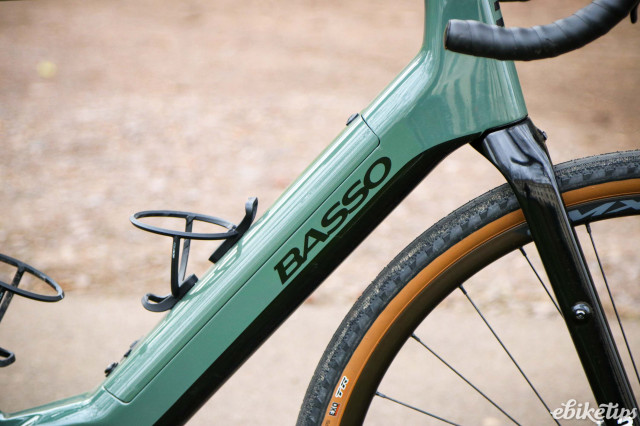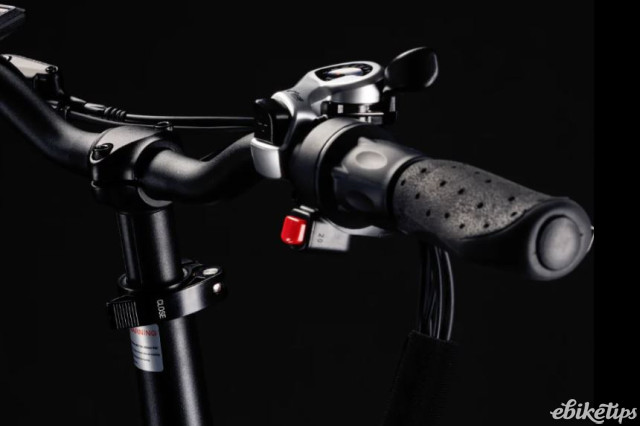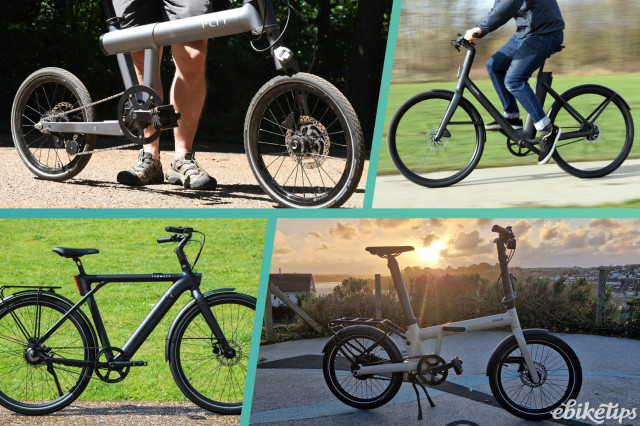Review: Basso Volta

Overview
- Smooth, punchy motor
- Good range
- Comfortable bike to ride
- No option to fit aftermarket dropper post
- Front end is very tall
- Standard tyres only suitable for dry, compact surfaces
With 75Nm of smoothly delivered torque and a maximum boost of 500W of power, the Basso Volta definitely provides the punch needed for tackling lumpy gravel trails or a bit of background assistance for tired legs on day rides. Its geometry and tyre clearance provide a confidence inspiring platform regardless of how rugged the terrain is too. In fact, the only thing that really goes against it is the weight, which at north of 15kg can make it feel a little ungainly at slow speeds - not ideal for those technical sections.
Ride
It won’t surprise you when I say that an e-bike is defined by its motor. I’ll go into the full technical specs a bit later, but thanks to the very smooth delivery of the 75Nm of torque on offer, the Volta is an easy bike to ride and generally live with.
I’ve ridden plenty of motors boasting huge torque numbers, but it's all in vain if the delivery is sluggish and choppy. The Polini motor here is responsive in terms of how it reacts to your pedalling input which allows you to feel more involved with the bike as a rider.
From a geometry point of view, there is nothing really out of the ordinary for a gravel bike with a steepish seat angle allowing you to get the power down on the climbs or on the flat sections when you are above the motor’s cut-out speed. The top tube length and therefore the reach figure is exactly where I’d expect it to be, although one thing that is a little different to most is the stack height which is on the tall side.
The large model I have here has a stack of 603mm, increased in part by the tall 180mm head tube. I didn’t find it a problem, In fact I quite liked the upright position allowing me to plan ahead on technical routes, but if you are looking for a gravel racer where you can hunker down and get all aero in the drops then this might not be the bike for you.
At around 15kg the Volta isn’t heavy in terms of the competition, but I feel that the weight is exaggerated by that tall ride position. When cornering while descending I felt that my higher centre of gravity took away some of my involvement with the front end, and when I leant the bike over it felt a bit top heavy - weird considering the bottom bracket motor is positioned so low down.
When the terrain or trail isn’t requiring such frantic inputs though the Basso is a joy to ride. The lengthy wheelbase gives plenty of stability and the slack head angle means that the steering never feels twitchy. The carbon fibre frame gives a pleasurable ride feel regardless of how rough the terrain is and that isn’t just down to the wide tyres.
Soft, wide tyres can’t mask a poor ride quality from a frameset and this Volta mixes stiffness and flex in a positive way.
The ride position of the Volta lends itself well to longer adventures and it’s on these journeys that I really bonded with it.
With that middle of the road geometry I mentioned a paragraph or so ago, the Volta works well as a long-distance mile muncher. It’s an easy bike to ride far, quickly, and responds well to being loaded up with bags and kit, making it the ideal off-road tourer - although factor in that you’ll need to carry the charger and find a hook-up to plug it in at the end of each day.
Overall, from a ride point of view the Volta is a very likeable machine, although I’d say it is most comfortable on less challenging, technical terrain.
Frame and fork
While ‘made in’ can have a host of connotations with regards to where things are ‘manufactured’ across bike brands, the term can be applied literally to Basso’s frames. They are literally designed and manufactured in Italy where the company is based.
I’ve ridden a wide range of Basso bikes over on road.cc and the framesets have always impressed me. As I said above the ride quality is very good indeed, and that’s achieved by using a high-quality carbon fibre composite, and having a knowledge of how to lay it up to create the characteristics you want from each specific part of the bike.
Both the frame and fork are created from Torayca T700-MR60 carbon fibre composite, which isn’t quite a slight or stiff as the T1000 used on high-end road and gravel bikes, but balances both of those while also bringing good durability thanks to good impact resistance - something you want on a gravel bike.
Saying that though there is plenty of protection on the underside of the frame to protect from rock impacts thrown up by the tyres.
It’s a well specced frame too with mounting points for mudguards, racks and the ability to run a dynamo system for charging lights or other devices. On the top tube you’ll find a couple of bolts for attaching a bento box style bag, and when not in use they sit discretely under a blanking plate.
Integration of pretty much everything means that the Volta looks clean and is snag free in terms of cables and hoses.
The Paradigma Integration System (the cockpit to you and I) includes the stem, headset and spacers all of which have been designed to run the brake hoses directly into the frame via the head tube. It can run up to five cable/hose runs, although that isn’t necessary here as this Volta is running SRAM’s Force wireless electronic groupset.
The seatclamp area is also integrated using Basso’s 3B system which uses three bolts and a vulcanised steel plank to grip the carbon seatpost. They say this design gives an anti-vibration characteristic. It’s not something I can say that I could feel though.
The specific seatpost shape means that fitting a dropper post isn’t an option.
Tyre clearance is generous at 45mm, and you get the usual attributes of 12mm thru axles and a replaceable gear hanger.
The range is spread over just four sizes ranging from small to extra-large equating to top tube lengths of 500mm to 590mm.
Ours is a large which comes with a 560mm top tube.
Basso has a geometry table on their website, but for a bit of reference I’ll give you some stats for our bike…
The seat tube is 540mm long sitting at an angle of 73.5°, while the 180mm head tube is much slacker at 71°. Stack and reach measurements are 603mm and 382mm respectively.
Motor and performance
Keeping things Italian Basso have specified a Polini EP3+ motor which as I’ve already touched on supplies 75Nm torque and the UK legal power output of 250W.
That 250W is kind of the nominal, say, average power it’s allowed to put out by UK law, but short spikes of peak power are acceptable for pulling away or when you really stamp on the pedals and for this the EP3+ can deliver 500W.
That 75Nm of torque means that the Volta feels punchy, coping well with steep climbs and acceleration feels brisk.
The on/off transition in relation to your pedalling motion is quick without feeling jerky which is a great feeling when you are switching between pedalling and freewheeling for tight corners or if you are in start/stop traffic in urban areas.
There is nothing worse than lag in the motor when you are trying to pull away quickly. There is a small amount of over-run when you stop pedalling, but it’s nowhere near as bad as I’ve known from some cheaper e-bikes I’ve ridden.
When riding the Volta above the speed limiter, there is no feeling of drag and it’s generally a quiet system to use.
Everything is controlled by a smart looking head unit on the handlebars and the level of assistance is controlled by a toggle switch on the handlebar. It has a button facing towards the rear of the bike, and one facing forward so operation is done by index finger and thumb - something that is very easy to control on the fly especially when I found myself spinning out on loose gravel and wanted to cut the power.
Inside the down tube you’ll find the Polini 500Wh Evo 13.8Ah battery with the power button position on the outside of the tube. It’s not the easiest of things to operate, especially in the colder weather with gloves on, as this button physically interacts with the button on the battery within. 'Vague' would be a good way to describe its operation - although thankfully you can also power off the unit by way of the head unit on the handlebar.
On flat terrain Polini gives a quoted range of around 220km (30%/level 1) to 60km (400%/level 5) for a road bike, and half that for an MTB, so a gravel bike should be somewhere in the middle.
My Salisbury Plain gravel loop is 50km on a mixture of surfaces and takes in just over 500m of climbing. With the battery fully charged and the motor set to Dynamic mode (a mixture of performance and range longevity) and an assistance level 5, I finished with about 10% battery life left, which I’d say is pretty good.
Range can also be increased with the addition of a bottle shaped extender battery.
With five levels of assistance on offer on each of the modes, there is plenty of adjustability on offer to balance performance while minimising range anxiety. The modes on offer are Touring, Dynamic and Race. You also get a 6km/h walking mode to help on any hike-a-bike ascents.
From flat, the frame battery takes around five hours to charge to full, which I didn’t think was too bad. According to my smart meter it was costing me about 20p for a full charge, which for the range on offer I’d say is decent value for money.
Finishing kit
The Volta is available in two builds, a 1x using SRAM’s mechanical Apex group, or the one that we have, the 2x SRAM Rival AXS.
It offers completely wireless shifting and, in this guise, gives you a wide-ranging 10-36T 12-speed cassette paired to a 48/35T chainrings on the non-group specific chainset.
Gears offering these ratios mean that you are covered at both ends with a low gear capable of hauling you up the steep inclines, especially with the addition of motor power, while at the other end it’s safe to say you aren’t going to find yourself spinning out.
Shifting both front and rear is quick and crisp, regardless of how dirty the drivetrain gets and while the mechs require their own batteries, giving you something else to charge, the range is good, and you’ll easily be covering 500+ miles between each one.
One neat thing about SRA’s AXS is that both mechs use the same battery design, so if one runs out (usually the front mech first) you can switch them around to put yourself in a ‘finish the ride gear’.
The Volta uses SRAM’s Paceline rotors in 160mm diameter front and rear which have enough power and bite to not be overwhelmed with the extra weight of an e-bike. The braking has a great feel to it and over the years SRAM have really improved their modulation and feedback at the lever. I found the setup to work very well regardless of what type of terrain I was on.
For the full in-depth details of Rival AXS you can check out the review over on our sister site, road.cc.
Away from the grouspet, you’ll find plenty of own branded stuff, like the stem, handlebar and seatpost - although Selle San Marco supply the saddle.
I like the short-nosed shape, and it has just enough padding to quash the rough surface without muting feedback from the bike in general.
Another benefit of using a bottom bracket mounted motor system over a rear hub based one is that you can run any off the shelf wheels that you like.
Straight out of the box you get a set of aluminium rimmed Microtech MX 25 that performed well throughout testing. The 24-spoke build front and rear proved to durable, and they are tubeless ready which is a bonus for gravel riding.
The tyres fitted as standard are Maxxis Receptors which are a decent choice if the surface is compacted and dry due to their minimal tread.
Unfortunately for the majority of the test period the weather wasn’t dry, and therefore the trails weren’t compacted. Instead they were wet, muddy and very slippery.
I swapped them for a set of Schwalbe G-One Bite, which were fitted throughout the review period. As good all-rounders they suit the nature of the Volta and made full use of that 45mm maximum clearance on 700c wheels.
Pricing and competition
The Volta is priced at £5,699 which all things considered is a decent price for a bike whose frame is manufactured in Europe on quite a small scale.
For comparison Specialized’s Turbo Creo 2 Comp comes in at £5,000 but comes fitted with a 1x Apex AXS groupset, sitting one rung below the Rival found here. It does get a set of DT Swiss wheels though and a dropper post.
We haven’t reviewed one (yet), but Suvi managed to get a first ride on the Spesh when it was released.
Richard reviewed the Advanced Offroad Pro Gravel a few months back and was generally impressed. It uses a Bosch SX motor system and also gets a SRAM AXS groupset, although the two options sit either side of the Rival found here. The Apex build costs £5,199 while the Force option is £6,399.
Canyon offer their Grizl gravel bike in an e-bike version calling it the Grizl:ON. There are four models in the range with the cheaper two using mechanical Shimano GRX groupsets, and the two upper using SRAM’s AXS systems.
The closest in price is the Force equipped CF9 at £6,499. It uses a Bosch SX motor, a SRAM 1x grouspet and comes with integrated lighting. For the extra cash you are getting a deep section set of carbon DT Swiss wheels and a suspension fork, You also get Canyon’s clever VCLS seatpost which uses a leaf spring design creating 20mm of vertical deflection. It’s very comfortable. You’ll find a full review here.
Beyond the Bosch options, Rebecca really liked the Cairn E-Adventure Rambler, which is built around the Fazua Ride 50 Street Drive Pack - although that Rambler version doesn't seem to be available at the minute.
Conclusion
Overall, the Basso is a well-made bike that is fun to ride with a thoughtfully specced motor system whose smooth and punchy nature improves the ride experience. For me the front end height took away some of the precision I like to have when riding a gravel bike, but if you are looking for a more relaxed position then this is definitely worthy of a look.























































